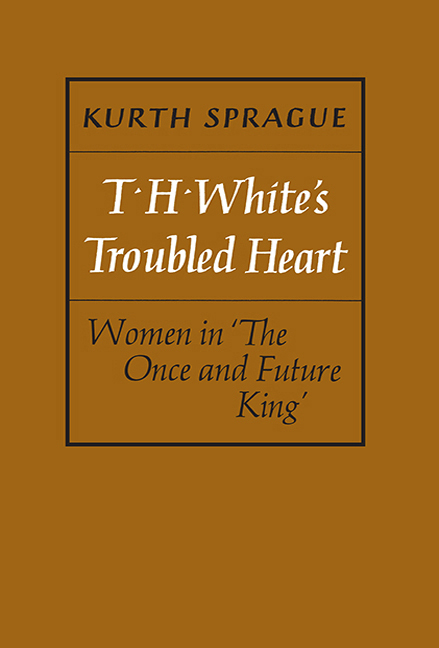Book contents
- Frontmatter
- Dedication
- Contents
- Miscellaneous Frontmatter
- Acknowledgements
- Foreword T. H. White Holdings at the Harry Ransom Center
- Preface
- Introduction
- Chapter One T.H. White
- Chapter Two Constance White
- Chapter Three White's Sources
- Chapter Four Omitted and Minor Characters
- Chapter Five Morgause
- Chapter Six Guenever
- Conclusion
- Appendixes
- Notes
- Survey of Criticism on White
- Bibliography
- Frontmatter
- Dedication
- Contents
- Miscellaneous Frontmatter
- Acknowledgements
- Foreword T. H. White Holdings at the Harry Ransom Center
- Preface
- Introduction
- Chapter One T.H. White
- Chapter Two Constance White
- Chapter Three White's Sources
- Chapter Four Omitted and Minor Characters
- Chapter Five Morgause
- Chapter Six Guenever
- Conclusion
- Appendixes
- Notes
- Survey of Criticism on White
- Bibliography
Summary
This study sets out to accomplish three main objectives. It attempts to show the difficulties under which T.H. White labored when he came to write about the women in The Once and Future King, and how these difficulties shaped his view of Lancelot, who was, for him, largely a figure of self-identification, and his depiction of Mordred, who became the incarnation of sexual transgression. Second, it tries to illustrate through a study of his writing process how White succeeded in overcoming his handicaps and created in Guenever a memorable female character. Third, in support of my arguments I've made available previously unpublished material written by White and by his mother, Constance White.
According to White himself, it was his mother's influence on him while he was a child that led him to regard women with deep distrust. In reading through his journals and diaries, one is rarely sensible of White entertaining a sexual response to a woman. Instead, women are frequently considered condescendingly almost as individuals of a separate species, worthy of his attention certainly, but inestimably less amiable than his favorite red setter, Brownie. It was well-nigh impossible for White to write of women fairly, or to treat sympathetically any woman from a background similar to his own who occupied a position of responsibility. When it came time to put women into the books he wrote, White labored under an immense disadvantage.
The alternately lavish attention and the austere indifference which so bewilderingly replaced it that the beautiful, capricious, and selfish Constance White exhibited to her son, together with his experiences of corporal punishment while at Cheltenham, either commenced or confirmed his tendencies toward sadism and homosexuality and sank deep into his character feelings of shame, ugliness, and self-blame. It is helpful to remember that, in White's time—particularly the years between the First and Second World Wars—the linkage between homosexuality and sadism was taken to be obvious and incontrovertible, possibly due in large measure to a growing general awareness of the prevalence, in English boys’ schools both prep and public, of what the French so delicately term le vice anglais. Today's thinking, of course, among psychologists is that there is likely no connection between the two, and most certainly not an inevitable one.
- Type
- Chapter
- Information
- T. H. White's Troubled HeartWomen in <I>The Once and Future King</I>, pp. 3 - 6Publisher: Boydell & BrewerPrint publication year: 2007

